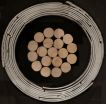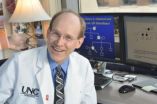Researchers work at the frontiers of islet cell transplantation
2011-02-18
(Press-News.org) Tampa, Fla. (Feb. 17, 2011) – Two studies published in the current issue of Cell Transplantation (19:12) investigate frontiers of islet cell transplantation for treating diabetes. Researchers in Milan, Italy re-examine the role of bone marrow stem cells in diabetic therapy and islet cell regeneration and Canadian researchers offer improved strategies for optimizing pancreatic islet culture in vitro.
Both studies are in the current issue of Cell Transplantation, freely available on-line at http://www.ingentaconnect.com/content/cog/ct/.
New perspectives on role of bone marrow stem cells in islet transplantation
The role of bone marrow (BM)-derived stem cells in the islet cell regeneration process continues to evolve. A team of Italian researchers reports that employing BM-derived stem cells as "feeder tissue," playing a protective role in supporting pancreatic islet repair for clinical use in treating diabetes, presents new therapeutic possibilities. Which cellular components of BM play the feeder role has not been clear.
"BM-derived cells have been found to differentiate into endothelial cells and their presence has been accompanied by a proliferation of recipient pancreatic cells that resulted in increased insulin production in the host pancreas," said corresponding author Dr. Lorenzo Piemonti.
The researchers speculate that BM plays a role as feeder tissue by modulating, or enhancing, vascularization.
"We recently demonstrated that pancreatic mensenchymal stromal cells (MSCs) originate from bone marrow cells," added Dr. Piemonti. "This suggests that there might be a 'cross talk' between bone marrow cells and the pancreas. Even more complex is the question of whether BM-pancreas cross talk plays a role in the pathogenesis of diabetes."
For the researchers, the 'easy availability' of BM, and that BM may offer "the ideal microenvironment for islet survival," suggest that exploring the possibility of using BM as the site for islet transplantation and they have started a clinical trial aimed at expanding on that idea.
"There is mounting evidence that BM and BM-derived stem cells can participate in the regeneration of pancreatic isolates," concluded Dr. Piemonti. "Future studies should evaluate their effect for the prevention and cure of diabetes should it be verifiable that there is a cross talk between BM and the pancreas."
Contact: Dr. Lorenzo Piemonti, Diabetes Research Institute, S. Raffaele Scientific Institute, Via Oligettina 60, 20132 Milan, Italy
Tel: 39-02-26432706 Fax : 39-02 -26432871
Email: piemonti.lorenzo@hsr.it
Citation : Ciceri, F.; Piemonti L. Bone Marrow And Pancreatic Islet: An Old Story With New Perspectives. Cell Transplant. 19(12): 1511-1522: 2010.
Improving pancreatic islet culture and preservation
Retrieving and preserving islet cells taken from nonliving donors for the purpose of islet cell transplantation to regenerate islet cells for patients suffering from diabetes is a current and successful practice. However, ensuring the integrity of the donor cells has been problematic.
"Following human islet isolation, apoptosis, or programmed cell death, occurs," said Dr. Maryam Tabrizian, member of a McGill University (Canada) research team. "Studies have shown that islet isolation exposes islets to a variety of stresses, including loss of vasculature and eventual hypoxia. These factors must be controlled to avoid cell death and the optimization of islet culture must be assured to prolong the survival and functionality of the cells in vitro."
According to the research team, nearly half of the islet mass is lost during donor surgery, preservation, transport and isolation, causing patients to undergo a second islet cell infusion. Better avenues of post-isolation culture, for up to two months duration, are needed, they said. This requires a better understanding of islet biology and the "basement membrane" of islet tissue. The researchers recommend combining many strategies supporting understanding of the need to maintain islet structural integrity and to provide a viable environment for islet preservation.
"Manipulation of the culture media, surface modified substrates, and the use of various techniques, such as encapsulation, embedding, scaffold and bioreactor approaches are among those strategies," concluded the researchers.
"The survival of islets after isolation remains a significant limiting factor in the field of islet transplantation." commented Dr. Rodolfo Alejandro, section editor for CELL TRANSPLANTATION and Professor of Medicine at the University of Miami Miller School of Medicine. The prevention and repair of islet damage during isolation is of paramount importance. These two studies discuss novel approaches for this problem.
Contact: Dr. Maryam Tabrizian, Duff Medical Building, 3775 University St. Room 313, Montreal, Canada QC H3A 2B4.
Tel: (514) 398-8129 Fax: (514) 398-7461
Email maryam.tabrizian@mcgill.ca
Citation: Daoud, J.; Rosenberg, L.; Tabrizian, M. Pancreatic Islet Culture and Preservation Strategies: Advances, Challenges, and Future Outlook. Cell Transplant. 19(12):1523-1535; 2010.
###
The editorial offices for Cell Transplantation are at the Center of Excellence for Aging and Brain Repair, College of Medicine, the University of South Florida and the Diabetes Research Institute, University of Miami Miller School of Medicine. Contact, David Eve, PhD. at celltransplantation@gmail.com or Camillo Ricordi, MD at ricordi@miami.edu
END
ELSE PRESS RELEASES FROM THIS DATE:
2011-02-18
Legal systems are necessary in any functioning society. Centuries ago, people realized that the only way to maintain a peaceful community was to develop a firm set of rules—laws—to punish transgressors. As laws have continued to evolve in societies around the world, psychological scientists have begun to investigate the psychological basis of many aspects of legal systems. A new special issue of Current Directions in Psychological Science, a journal of the Association for Psychological Science, presents the current state of research on psychology and law.
Many lawyers ...
2011-02-18
Athens, Ga. – New University of Georgia research has found that a statin drug that is often known by the brand-name Lipitor may help prevent blindness in people with diabetes.
In a study using diabetic rats, lead author Azza El-Remessy, assistant professor in the University of Georgia College of Pharmacy, and her colleagues found that statins prevent free radicals in the retina from killing nerves important to maintaining vision. The results of the study are published in the March edition of the journal Diabetologia.
"The exciting part is that there are now treatment ...
2011-02-18
Let algae do the dirty work.
Researchers at Rochester Institute of Technology are developing biodiesel from microalgae grown in wastewater. The project is doubly "green" because algae consume nitrates and phosphates and reduce bacteria and toxins in the water. The end result: clean wastewater and stock for a promising biofuel.
The purified wastewater can be channeled back into receiving bodies of water at treatment plants, while the biodiesel can fuel buses, construction vehicles and farm equipment. Algae could replace diesel's telltale black puffs of exhaust with cleaner ...
2011-02-18
The effect of a high-fat meal on blood vessel walls can vary among individuals depending on factors such as their waist size and triglyceride levels, suggests new research at UC Davis.
The new research reinforces the link between belly fat, inflammation and thickening of the arterial linings that can lead to heart disease and strokes.
Triglycerides are types of fat molecules, commonly associated with "bad cholesterol," known to increase risk of inflammation of the endothelium, the layer of cells that lines arteries.
"The new study shows that eating a common fast food ...
2011-02-18
When a team of scientists drilling near an Icelandic volcano hit magma in 2009, they had to abandon their planned experiments on geothermal energy. But the mishap could point the way to an alternative source of geothermal power.
"Because we drilled into magma, this borehole could now be a really high-quality geothermal well," said Peter Schiffmann, professor of geology at UC Davis and a member of the research team along with fellow UC Davis geology professor Robert Zierenberg and UC Davis graduate student Naomi Marks. The project was led by Wilfred Elders, a geology professor ...
2011-02-18
What NIST-led innovation is estimated to have saved U.S. industry $6.1 billion over the past 20 years? Well, probably several, but, perhaps surprisingly, a new economics study* points to the development of "role-based access control," a computer-security technology fostered and championed by the National Institute of Standards and Technology (NIST) in the 1990s.
Role-based access control (RBAC) is the idea of establishing standard levels of access—"permissions"— to the various computing resources and networks of an organization that are tailored to specific employee roles, ...
2011-02-18
A researcher at the National Institute of Standards and Technology (NIST) has invented a method of making high-temperature superconducting (HTS) cables that are thinner and more flexible than demonstration HTS cables now installed in the electric power grid while carrying the same or more current. The compact cables could be used in the electric grid as well as scientific and medical equipment and may enable HTS power transmission for military applications.
Described in a paper just published online,* the new method involves winding multiple HTS-coated conductors** around ...
2011-02-18
CHAPEL HILL, N.C. - In the ten years since the human genetic code was mapped, expectations among scientists, health care industry, policy makers, and the public have remained high concerning the promise of genomics research for improving health.
But a new commentary by four internationally prominent genetic medicine and bioethics experts cautions against the dangers of inflated expectations – an unsustainable genomic bubble – and it offers ways to avoid it while still realizing "the true – and considerable – promise of the genomic revolution."
"This commentary is ...
2011-02-18
EAST LANSING, Mich. — How does a scientist fuel his enthusiasm for chemistry after 60 years?
By discovering a new energy source, of course.
This week, SiGNa Chemistry Inc. unveiled its new hydrogen cartridges, which provide energy to fuel cells designed to recharge cell phones, laptops and GPS units. The green power source is geared toward outdoor enthusiasts as well as residents of the Third World, where electricity in homes is considered a luxury.
"SiGNa has created an inherently-safe solution to produce electric power, resulting in an eco-friendly and cost-effective ...
2011-02-18
Asthma may have a surprising relationship with the composition of the species of bacteria that inhabit bronchial airways, a finding that could suggest new treatment or even potential cures for the common inflammatory disease, according to a new UCSF-led study.
Using new detection methods, researchers learned that the diversity of microbes inside the respiratory tract is far vaster than previously suspected – creating a complex and inter-connected microbial neighborhood that appears to be associated with asthma, and akin to what has also been found in inflammatory bowel ...
LAST 30 PRESS RELEASES:
[Press-News.org] Researchers work at the frontiers of islet cell transplantation

